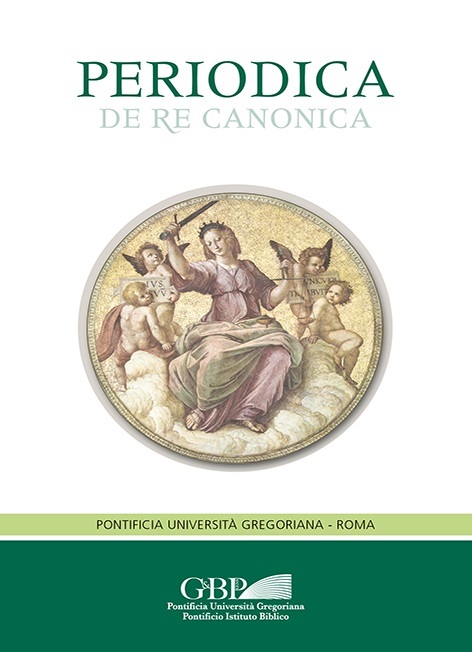Volume 112 - Issue 4
- Home
- Research and Publications
- Periodicals
- Periodica de Re Canonica
- Issues
- 2023
- Volume 112 - Issue 4

PERIODICA RE CANONICA - FIRST ISSUE 2023
Issue 112/4 (2023) of the magazine Periodica de re canonica, quarterly published by the Faculty of Canon Law of the Pontifical Gregorian University, is now available. To purchase online the entire dossier (paper/online issue) or individual items: https://www.unigre.it/en/research-and-publications/periodicals/periodica-de-re-canonica/
Ulrich Rhode, S.J., The Rotation of Pastors, 513-545
Summary: As established by can. 153 §1, the provision of an office that is not vacant is invalid. If this norm is overlooked and the conditions for an anticipated provision under can. 153 §2 are not met, this can easily result in invalid provisions. This can happen especially when the bishop plans to rotate pastors. However, there are several ways to simplify rotation projects and to avoid the risk of invalid provissions.
Keywords: rotation; vacancy; parish priest.
Gianfranco Card. Ghirlanda, S.J., The Roman Curia as an Example in the Renewal of Diocesan Curias, 547-580
Summary: The author begins with remarks that Pope Francis makes regarding the situation of profound crisis of faith in the society in which the Church currently lives and operates and so on the need for a pastoral and missionary conversion of all the structures of the Church in order to encourage a new evangelization. This process of renewal finds application in the reform of the Roman Curia brought about by the apostolic constitution Praedicate evangelium, a reform that becomes exemplary for the reform of diocesan curias by the diocesan bishops. The first application in this exemplary manner occurs with the apostolic constitution In Ecclesiarum communione, which seeks renewal in the vision of the Vicariate of the Diocese of Rome and in the reorganization of its structures and its functioning in a synodal sense. In this way the renewal of the Vicariate of Rome becomes exemplary for the reorganization of the diocesan curias. The author shows which bodies in the Vicariate of Rome have been reorganized and how this reorganization, with the necessary adaptations, can be applied also in diocesan curias.
Keywords: Roman Curia; Vicariate of Rome; diocesan Curia; conversion; renewal; reorganisation; evangelization; synodality.
Sunny Kokkaravalayil, S.J., Inter-Church Assembly (Can. 322): Its Competence to Make Particular Law for All The sui iuris Churches of a Territory, 581-615
Summary: The article argues that the conventus hierarcharum plurium ecclesiarum sui iuris [= inter-Church assembly (can. 322)] has legislative competence under certain conditions. However, the main purpose of this assembly is to promote the common good of all the Churches of its territory. The article introduced it from various angles such as its characteristics, canonical sources, purpose, membership, competence, references to it in CCEO, and whether it can express the synodality of the Church.
Keywords: Bishops’ conference; canon 322; Church; competence; eparchial bishop; inter-Church assembly.
Alan Modrić, S.J., The Figure of Vicar General and Episcopal Vicar in Light of Recent Ecclesial Legislation, 617-645
Summary: In the light of the apostolic constitutions Praedicate evangelium and In Ecclesiarum communione, the article seeks to understand the juridical figures of vicar general and episcopal vicar, taking particular account of the pastoral dimension of their offices. It’s highlighted how these offices might be updated in order to better respond to Pope Francis’ call to pastoral and missionary conversion of the hierarchical structures of the Church for a more effective evangelization in the world.
Keywords: vicar general; episcopal vicar; pastoral dimension; reform of the curia; evangelization.
Marcelo Gidi, S.J., Dogmatic-Conceptual Analysis of Can. 1376 §1, 2°: Protected Interest and Tort, 647-688
Summary: This paper provides an analysis of the most relevant innovations introduced in new Book VI of the Code of Canon Law concerning offenses in patrimonial and economic matters. Specifically, it examines and comments on the main issues at hand with regard to the criminal hypothesis in can. 1376 §1, 2°, which introduces new offenders to counter all forms of corruptive dynamics in the management and administration of ecclesiastical goods. In a critical exposition this paper emphasizes the qualities of, and possible improvements to the new canon, highlighting, in the light of the theory of protected legal interest, some inadequacies regarding the drafting and configuration of the offense. The paper concludes with the presentation, from a de iure condendo perspective, of some proposals for rearranging and interpreting both the elements necessary for the configuration of these offenses and the application of the penalty.
Keywords: canon penal law; crimes of patrimonial nature; typification; ecclesiastical temporal good; management; administration; protected legal good; penalties.
For annual subscriptions in different formats (paper, pdf, paper + pdf) please visit the webpage: https://www.unigre.it/en/research-and-publications/periodicals/periodica-de-re-canonica/